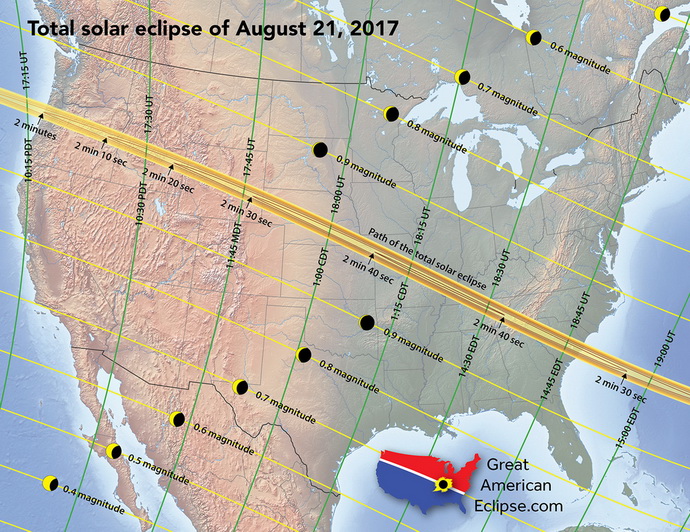
Mixing Ham Radio Microwaves With the 2017 Solar Eclipse
Why Nebraska?
On Monday, August 21, 2017, a total eclipse of the Sun will be visible from within a narrow corridor that traverses the U.S. Although a partial eclipse will be seen from all of North America, the total phase in which the moon completely covers the Sun (known as "totality") will only be seen from within the narrow path of the Moon's umbral shadow as it sweeps across the U.S. (see Figure 1, below). Note that the path of totality paints a long swath through the state of Nebraska. Nebraska is also a convenient 1 day's drive from Minnesota (home of the NLRS) as well as from the locales of many 10 GHz+ operators in the Midwest (see Figure 2). And because it is a very flat state, Nebraska offer great views of the horizon in nearly all directions, making it an ideal place to operate on the microwave bands!
Graphic courtesy of greatamericaneclipse.com.
of totality of the 2017 solar eclipse. Nebraska, being a very flat state, offers great views of
the horizon in nearly all directions, making it an ideal place to operate on the microwave bands.
It's also important to take into account the general weather conditions, especially as they relate to cloud cover, at potential sites to observe the eclipse. August is generally a very good month for viewing an eclipse across the U.S since the peak of the thunderstorm season has past and sunshine is usually abundant. Western Nebraska is nearly ideal in this regard, as can be seen in Figure 3 below, which shows the average U.S. August afternoon cloud cover derived from 22 years of satellite observations.
Proposed 10 GHz+ Contest Rove Routes
Since there are no known native 10 GHz+ operators in Nebraska, we've decided to generate some intra-Nebraska contest action of our own by creating 2 distinct rover groups, with one following a northern route and one following a southern route (see Figure 4 below).
Northern Route
We see the northern rover pack starting out Saturday in Norfolk, Nebraska, roving westward along US 275 and US 20, ending up Saturday night in Ainsworth, Nebraska. Along this route are some nice ridges and beautiful vistas, which make for some great 10 GHz+ operating sites. QSOs should be possible with the fixed Northern Lights Radio Society (NLRS) ops on Buck Hill near Burnsville, Minnesota; with a small NLRS rover pack that plans to be in NW Iowa; and with the Nebraska southern route rovers. We also hope to encourage the St. Louis Area Microwave Society (SLAMS) members who, if not interested in roving with us in Nebraska, might consider doing portable ops near St. Joseph, Missouri. By locating in St. Joseph, SLAMS ops could easily work both the northern and southern Nebraska rover packs during the weekend and be in a prime location to view the total eclipse on Monday (see the graphic above).
On Sunday, we see the northern rover pack heading out of Ainsworth and working their way along US 20 towards Valentine, Nebraska, then dropping south to end up in Ogallala, Nebraska by nightfall to meet up for a nice dinner, cocktails, and conversation with the southern route rovers (see below for southern route details). It's worth noting that as both Nebraska rover groups continue westward, it will become increasingly difficult to make QSOs with the groups mentioned earlier. Therefore, we foresee that QSOs on Sunday will mainly take place between the northern and southern Nebraska rover groups. However, as both groups approach Ogallala, we should be with range of the Rocky Mountain microwave group, and we will encourage them to turn their dishes towards us to pick up some unique Qs!
Southern Route
We see the southern rover pack starting out Saturday in Beatrice, Nebraska, roving westward along US 136, and ending up Saturday night in Holdrege, Nebraska. Like the northern route, this route has some nice ridges and beautiful vistas, which make for some great 10 GHz+ operating sites. QSOs should be possible with the small NLRS rover pack that plans to be in NW Iowa and with the Nebraska northern route rovers. QSOs with 10 GHz ops in the St. Louis area might also be possible, but certainly with any SLAMS members who might migrate northwestward towards St. Joseph, MO as discussed earlier.
On Sunday, we see the southern rover pack heading out of Holdrege and working its way westward along US 34/US 6, then then heading north at the end of day to end up in Ogallala, Nebraska to meet up with the northern rover pack. Again, it's worth noting that as both rover groups continue westward, it will become increasingly difficult to make QSOs with the groups mentioned above; so, we foresee that QSOs on Sunday will mainly take place between the northern and southern Nebraska rover groups, while late in the day we should be within range of the Rocky Mountain microwave group to pick up some more Qs.
| Page Last Updated: 18 Jun 2017 |



